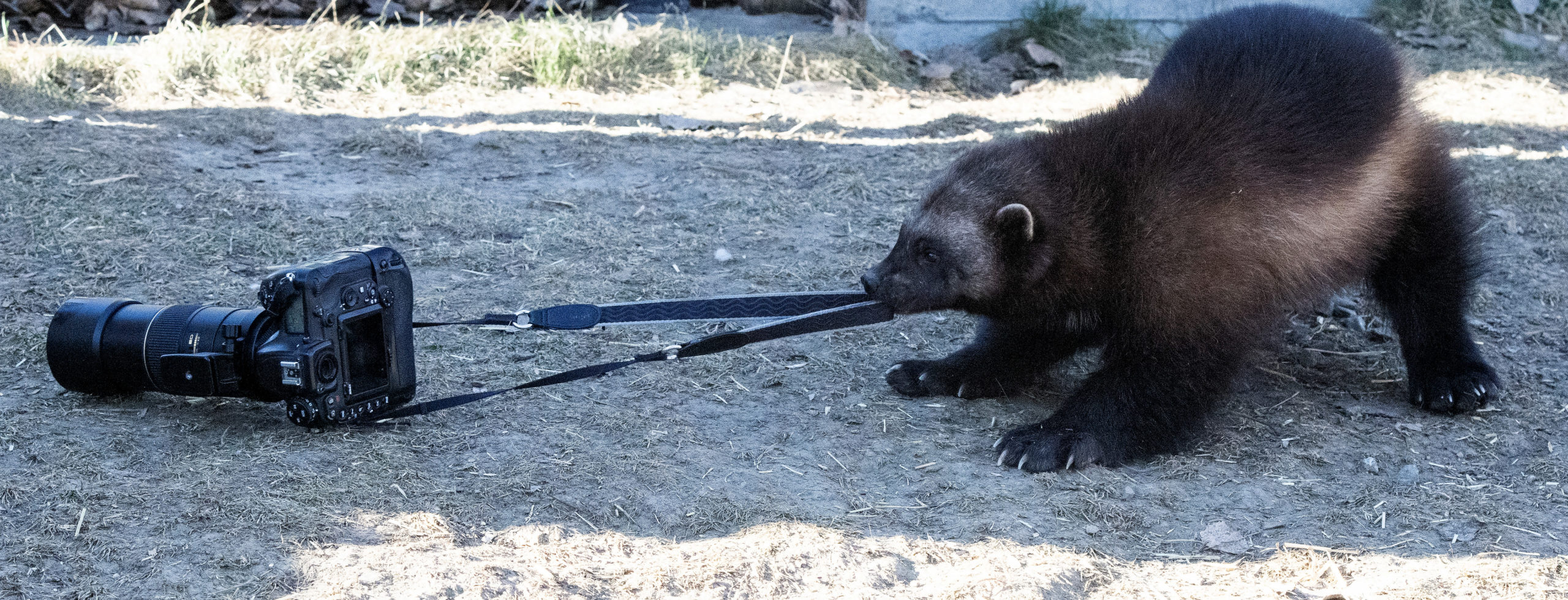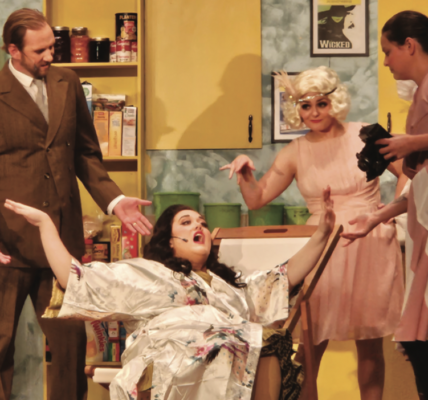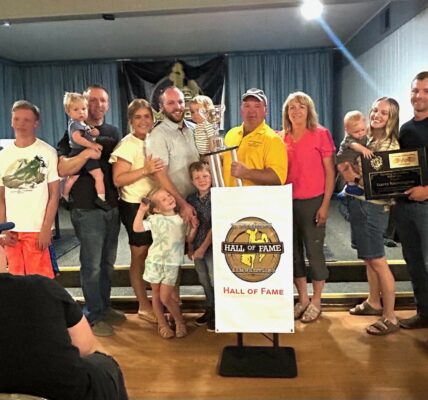ZooMontana one of three zoos in nation with successful wolverine breeding programs

Kovaa, an immature male wolverine born at ZooMontana, grabs a camera brought in by Powell Tribune photojournalist Mark Davis. The camera was uninjured in the incident. Photo by Mark Davis, Powell Tribune.
• Saving the ‘woods devil’
By Mark Davis
Powell Tribune
Via- Wyoming News Exchange
POWELL — When the U.S. Fish and Wildlife Service announced federal protections for wolverines in the lower 48 states in late November, attention immediately turned to conservation efforts.
The formidable predator is native to Wyoming — especially in the Greater Yellowstone Ecosystem — but very few people will ever see one of these spectacular carnivores. That is, unless you load up the family truckster and head to ZooMontana.
Once there, you can watch Sid and Ahmari, the zoo’s famous wolverines, in their cozy and secure, tree-filled enclosure at the Billings zoo.
But what few may realize is the two toothy skunk bears are part of a special conservation effort that has been ongoing since their arrival from two Scandinavian countries in 2017.
The program, which is sponsored by the European Association of Zoos and Aquariums (EAZA), is designed to save a genetically pure line of the species and with the hopes of boosting wild populations if they crash. The zoo is one of only three in the U.S. to have a successful captive breeding program.
After years of hoping, zoo officials were proud to announce the miracle of birth for their first litter, two males named Kovaa and Villi, earlier this year.
Yet considering the zoo was in dire straits a little more than a dozen years ago, making the necessary changes to qualify for the international program was in itself somewhat of a miracle, let alone finally being able to contribute its first new members to the breeding program.
In 2011, ZooMontana was in jeopardy of closing due to severe financial issues. The zoo was in desperate need of some fresh ideas and advertised nationally for a new executive director.
That’s when Jeff Ewelt first heard of the zoo.
Ewelt, who has a degree in environmental communication and interpretation from Ohio State University, immediately started considering the opportunity, though friends thought he was foolish for applying for the job. It was well known in the tight knit zookeeper community that ZooMontana was hitting “rock bottom,” Ewelt said. The zoo had lost its Association of Zoos and Aquariums (AZA) accreditation and the possibility of closing was discussed.
However, love for a challenge and Ewelt’s firm belief in a zoo’s importance in a community led him to apply.
Ewelt has known he wanted to work with wildlife since he was in the sixth grade. He was living in Cleveland at the time and had an opportunity to job shadow a wildlife biologist at a local science center.
“The gentleman that I was shadowing let me hold an owl at the end of the day. The moment the owl was in my hands I knew what I needed to do with my life,” he said.
However, even after earning a degree, finding gainful employment working with wildlife was a challenge. His first job out of college was at the Columbus Zoo. But it was selling “Pepsis and hotdogs — just to get my foot in the door,” he said. It took another two years to get a promotion to work with wildlife.
After gaining experience working with wild birds, Ewelt moved to ZooTampa in Florida. He worked as an animal ambassador and trainer for about a decade before he saw the ad for the ZooMontana job.
Ewelt accepted an offer for the position and quickly helped make the zoo a viable entity and regain its accreditations.
Twelve years later, the zoo has made great strides in attracting supporters and adding new exhibits. Spending even a short amount of time with Ewelt reveals a joy for life, a man constantly consumed by his mission and a passion for conservation.
Zoos are one of the best ways to share love for charismatic wildlife and the need for conservation with the community, he said. And zoos are often the last stand for endangered species — especially those extinct in the wild — and could become more important as climate change presses many species to the brink.
About 230 zoos and aquariums are members of the AZA, working to provide safe habitats, medical care, and nurturing environments for their animals. They also concentrate on protecting endangered species, including conducting, supporting and funding research and conservation; advocating for conservation and wildlife, funding, and science; and working with government agencies, universities, non-governmental organizations and other partners to establish conservation initiatives.
However, when it came down to the EAZA-sponsored wolverine breeding program, he thought it best to use a hands-off approach on the kits.
Once Ahmari gave birth, Ewelt said he and ZooMontana caretakers allowed her to “do her thing” without interruptions. The crew kept its distance while worrying endlessly, especially during the unusually warm winter.
Wolverines typically raise their kits in snow tunnels in the wild and are known to abandon their young if their habitat isn’t perfect. They even have the ability to delay pregnancy, called embryonic diapause, until circumstances improve.
“The wolverine may be second only to the polar bear in its sensitivity to global warming,” said U.S. Forest Service wolverine researcher K. B. Aubry, who does long-term radio-telemetry studies of wolverines.
At the zoo, Ahmari was raising her two youngsters in a hollow log in their outdoor enclosure, but moved them to one of their indoor kennels when melting snow made the log too wet for them to survive.
It was hard for the zoo crew to stand back, knowing how rare it is for wolverine kits to survive after being born in captivity. Ewelt theorizes a hands-on approach may be too much stress for the young of the solitary species.
“When larger organizations have these babies, they want to get their hands on them. And for good reason. They want to get weights and make sure they get blood samples and do tests,” he said. “We decided to take a hands-off approach because wolverines born in captivity often don’t survive.”
Wolverine kits are born entirely white, blind, and weigh less than 1 pound. They will wean within 10 weeks, developing rapidly and reaching adult size by the end of the year, according to the zoo. The effort was all on Ahmari because male wolverines do not help in the rearing of kits.
Sid and Ahmari were brought to Billings from Sweden and Norway in 2017. Yet it took until 2023 for the pair to have their first litter.
Fortunately, the kits thrived at ZooMontana and are now healthy additions to the program to help save the species around the world. Villi was transferred to the San Francisco Zoo breeding program earlier this year and Kovaa was shipped to the Minnesota Zoo in a suburb of Minneapolis earlier this week.
None of the wolverines in the EAZA program will ever go free, Ewelt said. Instead they serve as vessels carrying the pure genetics of the species forward and as educational animals carrying the message of conservation to communities around the world.






